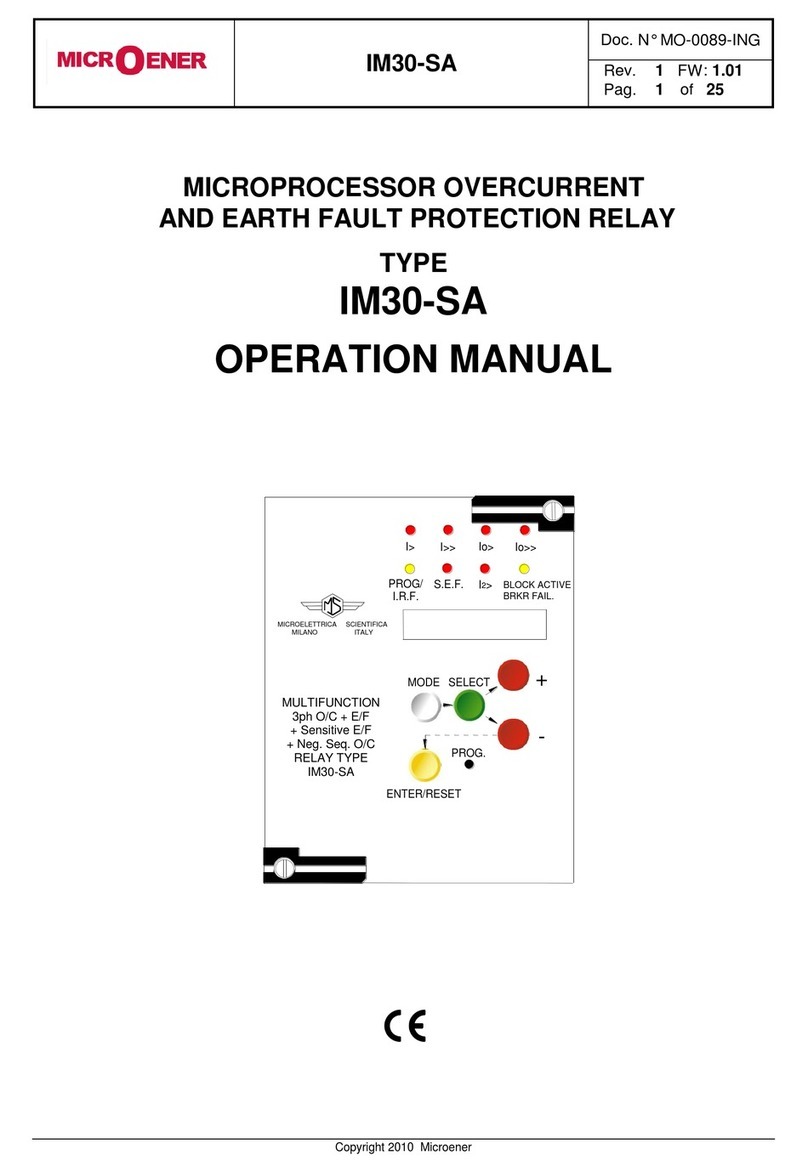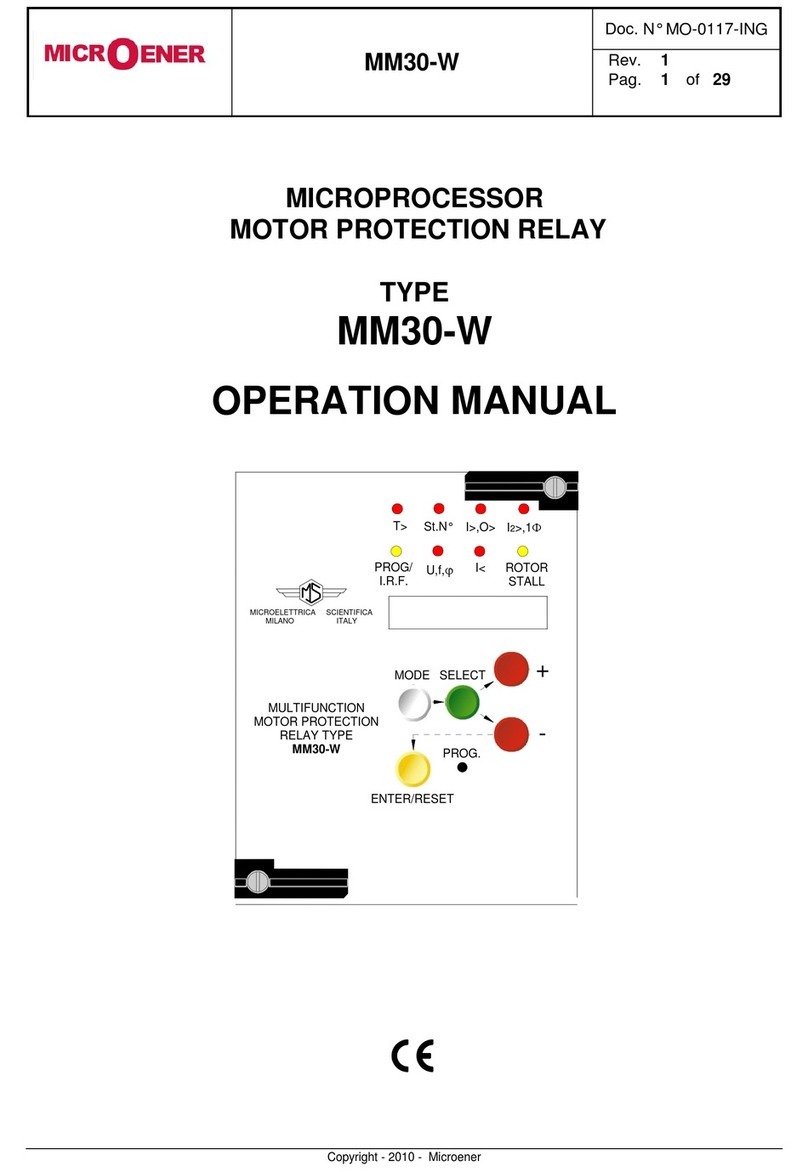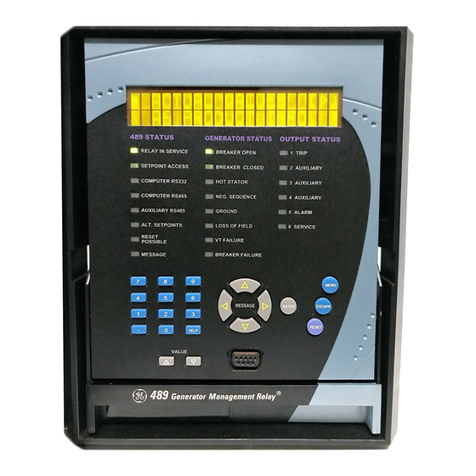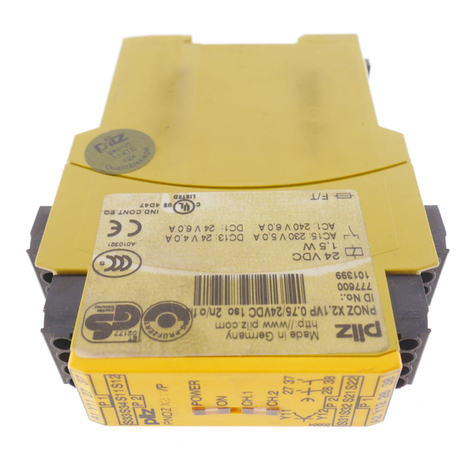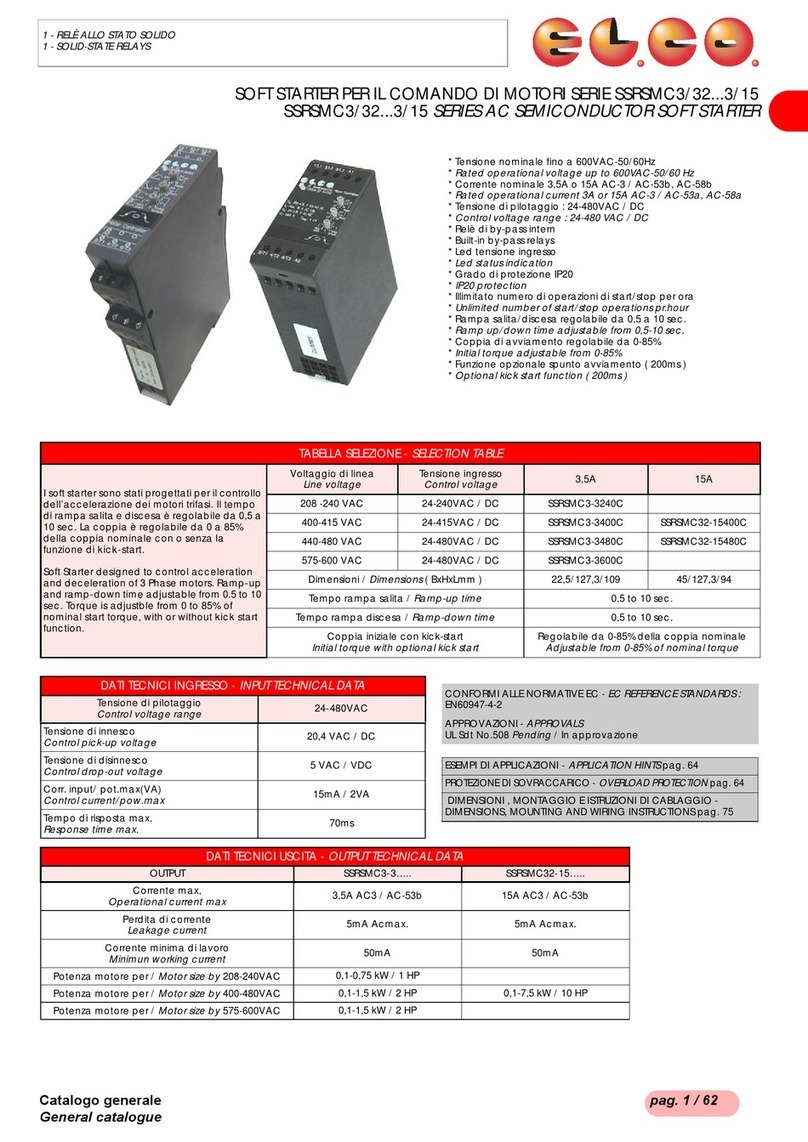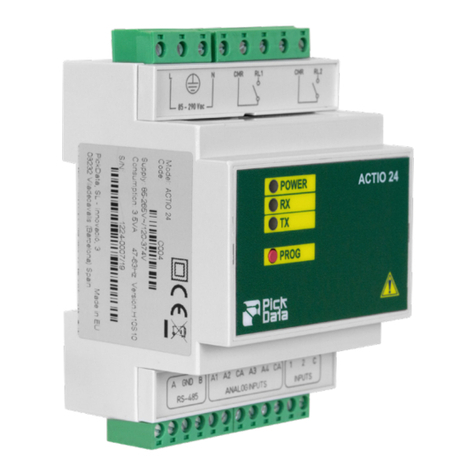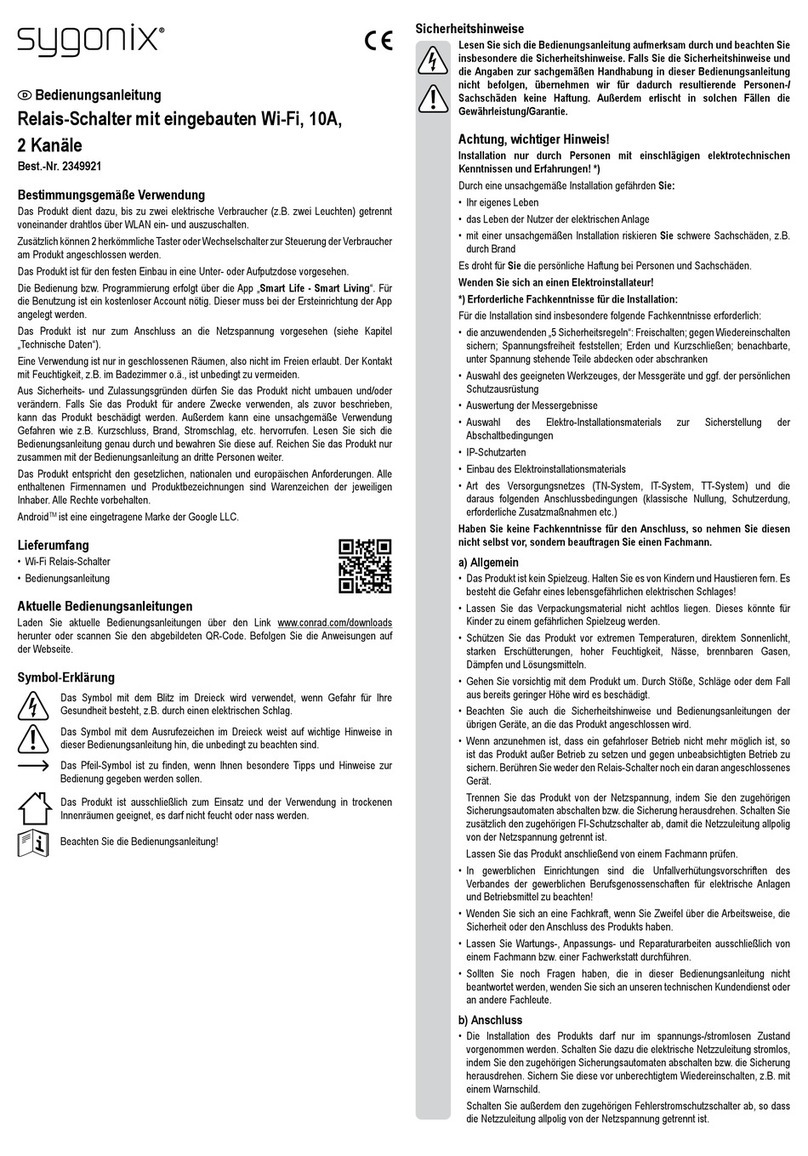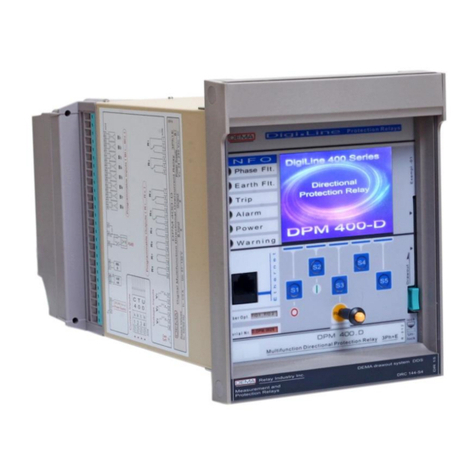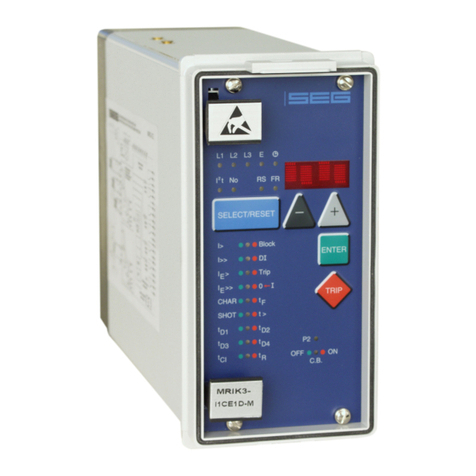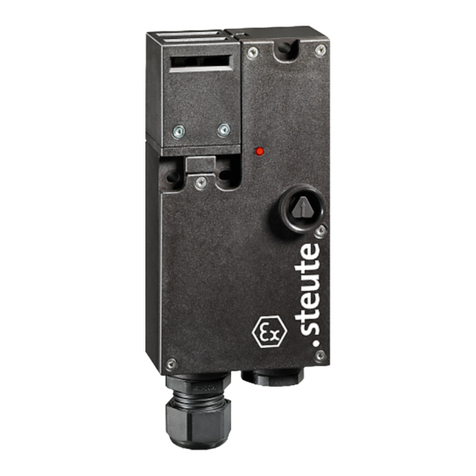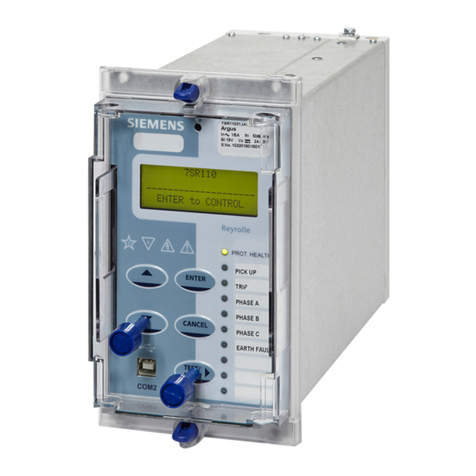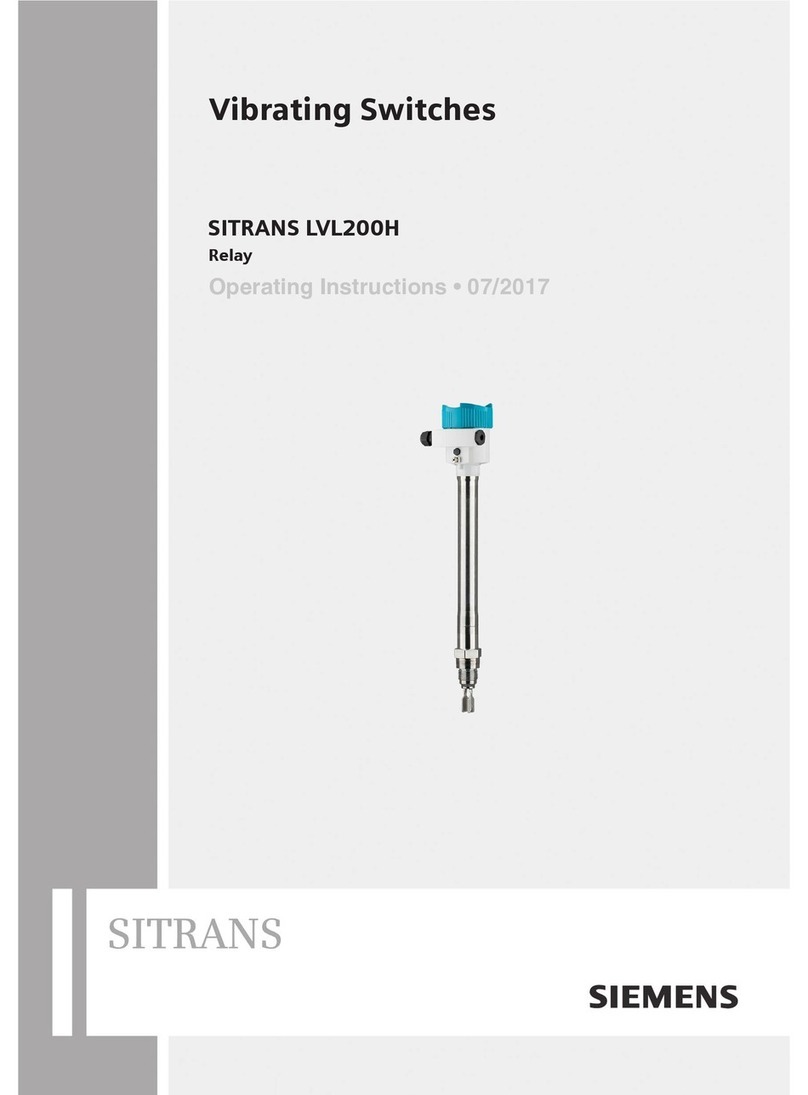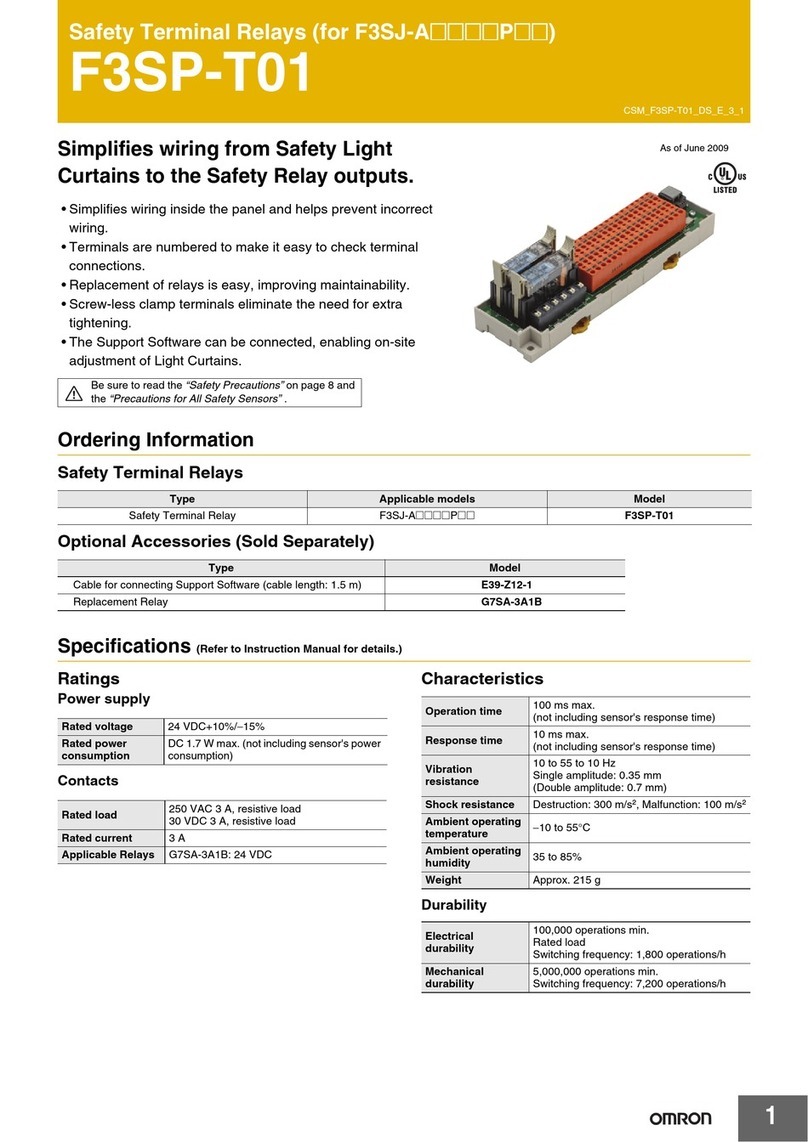MICROENER IM3G-VX User manual

IM3G-VX
Doc. N° MO-0068-ING
Rev. 1
Pag. 1 of 36
1
Mod.710
31/05/00
P. Brasca
D. Ciminaghi
0
EMISSION
10/03/98
P. Brasca
D. Ciminaghi
-
REV.
DESCRIPTION
DATE
PREP.
CONTR.
APPR.
MULTIFUNCTION MICROPROCESSOR
PROTECTION RELAY
TYPE
IM3G-VX
OPERATION MANUAL
Copyright 2010 Microener
GENERATOR
PROTECTION
RELAY TYPE
IM3G-V
ENTER/RESET
MODE
SELECT
+
-
PROG.
I2>
T>
PROG/
I.R.F.
MICROELETTRICA SCIENTIFICA
MILANO ITALY
I>-I>>
U,f
Z<
W
B.I./
B.F.

IM3G-VX
Doc. N° MO-0068-ING
Rev. 1
Pag. 2 of 36
Copyright 2010 - Microener
INDEX
1 General utilization and commissioning directions __________________________________________3
1.1 Storage and transportation__________________________________________________________ 3
1.2 Installation_______________________________________________________________________ 3
1.3 Electrical connection_______________________________________________________________ 3
1.4 Measuring inputs and power supply___________________________________________________ 3
1.5 Outputs loading___________________________________________________________________ 3
1.6 Protection earthing_________________________________________________________________3
1.7 Setting and calibration______________________________________________________________ 3
1.8 Safety protection__________________________________________________________________ 3
1.9 Handling_________________________________________________________________________3
1.10 Maintenance_____________________________________________________________________ 4
1.11 Fault detection and repair___________________________________________________________ 4
2 General characteristics and operation____________________________________________________ 4
2.1 Power supply_____________________________________________________________________ 4
2.2 Measuring input___________________________________________________________________ 5
2.3 Algorithms of the different functions___________________________________________________ 6
3 Controls and measurements____________________________________________________________ 12
4 Signalization_________________________________________________________________________ 13
5 Output relays_________________________________________________________________________14
6 Serial communication__________________________________________________________________15
7 Digital inputs_________________________________________________________________________16
8 Test________________________________________________________________________________ 16
9 Keyboard and display operation_________________________________________________________ 17
10 Reading of measurements and recorded parameters________________________________________18
10.1 ACT. MEAS (Actual measure)___________________________________________________ 18
10.2 MAX VAL (Max values)_______________________________________________________18
10.3 LASTTRIP (Last trip)_________________________________________________________ 19
10.4 TRIP NUM (Trip number)______________________________________________________ 19
11 Reading of programmed settings and relay’s configuration__________________________________ 19
12 Programming_________________________________________________________________________20
12.1 Programming of functions settings________________________________________________ 20
12.2 Programming the configuration of output relay_______________________________________ 22
13 Manual and automatic test operation_____________________________________________________ 23
13.1 Mode “ TESTPROG “ subprogram “ W/O TRIP “_____________________________________ 23
13.2 Mode “ TESTPROG “ subprogram “ With TRIP “_____________________________________ 23
14 Maintenance_________________________________________________________________________ 23
15 Electrical characteristics_______________________________________________________________ 24
16 Connection diagram (Standard Output)____________________________________________________ 25
16.1 Connection Diagram (Double Output)_________________________________________________25
17 Wiring the serial communication bus_____________________________________________________26
18 Change phase rated input 1A or 5A______________________________________________________ 26
19 Time current curves F51_______________________________________________________________ 27
20 I2t = constant element F46______________________________________________________________ 28
21 Thermal Image Curves_________________________________________________________________ 29
22 Direction for pcb’s draw-out and plug-in__________________________________________________ 30
22.1 Draw-out____________________________________________________________________ 30
22.2 Plug-in______________________________________________________________________30
23 Overall dimensions____________________________________________________________________31
24 Keyboard operational diagram__________________________________________________________ 32
25 Setting’s form________________________________________________________________________ 33

IM3G-VX
Doc. N° MO-0068-ING
Rev. 1
Pag. 3 of 36
Copyright 2010 - Microener
1. General utilization and commissioning directions
Always make reference to the specific description of the product and to the
Manufacturer's instruction. Carefully observe the following warnings.
1.1 - STORAGE AND TRANSPORTATION,
must comply with the environmental conditions stated on the product's instruction or by the
applicable IEC standards.
1.2 - INSTALLATION
must be properly made and in compliance with the operational ambient conditions stated by the
Manufacturer.
1.3 - ELECTRICAL CONNECTION
must be made strictly according to the wiring diagram supplied with the Product, to its electrical
characteristics and in compliance with the applicable standards particularly with reference to human
safety.
1.4 - MEASURING INPUTS AND POWER SUPPLY
carefully check that the value of input quantities and power supply voltage are proper and within the
permissible variation limits.
1.5 - OUTPUTS LOADING,
must be compatible with their declared performance.
1.6 - PROTECTION EARTHING
When earthing is required, carefully check its effectiveness.
1.7 - SETTING AND CALIBRATION
Carefully check the proper setting of the different functions according to the configuration of the
protected system, the safety regulations and the co-ordination with other equipment.
1.8 - SAFETY PROTECTION
Carefully check that all safety means are correctly mounted, apply proper seals where required and
periodically check their integrity.
1.9 - HANDLING
Notwithstanding the highest practicable protection means used in designing M.S. electronic circuits,
the electronic components and semiconductor devices mounted on the modules can be seriously
damaged by electrostatic voltage discharge which can be experienced when handling the modules.
The damage caused by electrostatic discharge may not be immediately apparent but the design
reliability and the long life of the product will have been reduced. The electronic circuits reduced by
M.S. are completely safe from electrostatic discharge (8 KV IEC 255.22.2) when housed in their
case; withdrawing the modules without proper cautions expose them to the risk of damage.

IM3G-VX
Doc. N° MO-0068-ING
Rev. 1
Pag. 4 of 36
Copyright 2010 - Microener
a. Before removing a module, ensure that you are at the same electrostatic potential
as the equipment by touching the case.
b. Handle the module by its front-plate, frame, or edges of the printed circuit board.
Avoid touching the electronic components, printed circuit tracks or connectors.
c. Do not pass the module to any person without first ensuring that you are both at
the same electrostatic potential. Shaking hands achieves equipotential.
d. Place the module on an antistatic surface, or on a conducting surface which is at
the same potential as yourself.
e. Store or transport the module in a conductive bag.
More information on safe working procedures for all electronic equipment can be found
in BS5783 and IEC 147-OF.
1.10 - MAINTENANCE
Make reference to the instruction manual of the Manufacturer ;
maintenance must be carried-out by specially trained people and in strict conformity
with the safety regulations.
1.11 - FAULT DETECTION AND REPAIR
Internal calibrations and components should not be altered or replaced.
For repair please ask the Manufacturer or its authorised Dealers.
Misapplication of the above warnings and instruction relieves the Manufacturer of any liability.
2. GENERAL
Input currents are supplied to 3 current transformers and 3 potential transformers respectively
measuring phase currents and phase-to-neutral voltages. Phase current input can be 1 or 5A (movable
jumpers an relay’s card). Rated voltage input can be programmed from 100 to 125V (phase-to-phase)
50 or 60Hz.
Time-current curves, operation algorithms and performances are reported in relay catalogue and in this
manual together with diagrams and dimension drawings.
Make electric connection in conformity with the diagram reported on relay's enclosure.
Check that input quantities are same as reported on the diagram and on the test certificate.
The auxiliary power is supplied by a built-in interchangeable module fully isolated an self protected
2.1 - POWER SUPPLY
The relay can be fitted with two different types of power supply module:
24V(-20%) / 110V(+15%) a.c. 80V(-20%) / 220V(+15%) a.c.
a) - b) -
24V(-20%) / 125V(+20%) d.c. 90V(-20%) / 250V(+20%) d.c.
Before energizing the unit check that supply voltage is within the allowed limits.

IM3G-VX
Doc. N° MO-0068-ING
Rev. 1
Pag. 5 of 36
Copyright 2010 - Microener
2.2 - Measuring input
The relay computes the RMS value of current and voltage and the relevant phase displacement.
2.2.1 Phase currents are supplied to three current transformers with 5A rated primary. By movable
jumpers on the relay card, the secondary can be switched-on to two different taps to obtain a
relay rated input current In = 5 or 1 Amp (different values can be provided on request).
The measuring dynamics of the C.Ts. runs from 0.001 through 50 times In.
For the phase current the measuring range of the A/D Converters runs from 0 to 13In
automatically switched to two channels one measuring from 0 to 1.3In and the second from 0 to
13In. The theoretical accuracy of the measurement is 0.12%In from 0 to 1.3In and 1.2%In from
1.3 through 13In.
The actual absolute error on each measurement M can be:
- 1 = 0.02 M 0.002 In from 0 to 1.3 In
- 2 = 0.02 M 0.02 In from 1.3 to 13 In
2.2.2 Phase-to-neutral voltages are supplied to three Potential transformers rated 220V. Relay’s rated
phase-to-phase input voltage (Uns) can be adjusted from 100 through 125V.
The ADC converter measuring range runs up to 2 x Uns.
The theoretical accuracy is 0.2%Uns.
The actual absolute error can be :
- v = 0.02 M 0.003 Uns
2.2.3 - Phase displacement
The relay detects the displacement between the input voltage of phase C and each phase
current IA, IB, IC. The displacement angle are therefore :
A= A-C -120° ; B= B-C + 120° ; C= C-C
This means that the voltage system is considered to be
balanced as it is normally, where as the currents can be
however unbalanced. (see figure)
Angles are measured anticlockwise from 0° to 360° with
accuracy 2°.
Displacement is not measured if current or voltage are null.

IM3G-VX
Doc. N° MO-0068-ING
Rev. 1
Pag. 6 of 36
Copyright 2010 - Microener
2.3 - Algorithms of the different functions
2.3.1 - Setting range of the reference input quantities :
- System frequency : Fn = (50-60)Hz
- Rated primary current of phase C.Ts. : In = (0-9999)A, step 1A
- Rated secondary phase-to-phase voltage of P.Ts. : Uns = (100-125)V, step 1V
- Relay basic current (Generator’s rated current) : Ib = (0.5-1.1)In, step 0.1In
2.3.2 - F49 - Thermal overload
The relay computes a thermal image of the machine based on the ratio I/[Ib] of the RMS of the
current flowing in each phase to the rated full load current of the generator :
- Warming-up time constant : Tc = (2 - 400)m, step 1m
- Maximum continuous overload : Ic = 1.05Ib (110%Tn)
- Rated full load (I=Ib) temperature rise : Tn
- Overtemperature prealarm level : Ta = (50-110)% Tn, step 1%
- Current corresponding to machine’s temperature before the overload : Ip (Tp)
- Time to warm-up from Tp to trip temperature (110%Tn) in function of the current overload
22
22
(Ib/[Ib])(I/[Ib]) (Ip/[Ib])(I/[Ib])
[Tc]ln
(Tb/Tn)(Tx/Tn) (Tp/Tn)(Tx/Tn)
[Tc]lnt
(see curves TU0325 §20)
Cooling is computed with the same time constant (Tc) as heating.

IM3G-VX
Doc. N° MO-0068-ING
Rev. 1
Pag. 7 of 36
Copyright 2010 - Microener
2.3.3 - F50/51 - Dual level 3-phase overcurrent with or without voltage control
F1 50/51 : Low set overcurrent
- Voltage control activated / non activated : I>/U = ON-OFF
- Pick-up (operation) level : I> = (1-2.5)Ib, step 0.01Ib
Setting I> = Dis blocks function’s operation
- Drop-out ratio 0.95
- Minimum operation time of instantaneous output 30ms
- Trip time delay in the definite time operation mode F(I>) = D :
t = tI> = (0.05-30)s, step 0.01s
- Trip time delay in the inverse time operation mode F(I>) = SI :
t0.033 tI
(I / I ) 1
0.02
; (tI> = trip time delay at I/I> = 5)
(see curves TU0311 §18)
F2 50/51 : High set overcurrent
- Voltage control activated / non activated : I>>/U = ON-OFF
- Pick-up (operation) level : I>> = (1-12)Ib, step 0.1Ib
Setting I>> = Dis blocks function’s operation
- Drop-out ratio 0.95
- Minimum operation time 30ms
- Independent trip time delay : t = tI>> = (0.05-3)s, step 0.01s

IM3G-VX
Doc. N° MO-0068-ING
Rev. 1
Pag. 8 of 36
Copyright 2010 - Microener
2.3.4 - Voltage controlled overcurrent
If the parameters I>/U and/or I>>/U are set to “ON” the voltage controls is active respectively
for the level I> and/or I>>. The actual pick-up levels (I>,I>>) variate in respect to the programmed
levels ([I>] , [I>>]) proportionally to variation of the voltage according to the curve herbelow
I
[I ],I
[I ]Actual pick - up level
[Set pick- up level]
U
[Uns] Actual voltage
[Rated input voltage]
The voltage ratio is measured on each phase
Ex 3
[Uns]
and the smallest among the values is
used in the algorithm. Practically in the zone between 0.2 and 0.8 Uns, the relay operates as
underimpedance protection when
Zx Ex
Ix [Uns]
3[I ],[Uns]
3[I ]
.
2.3.5 - F46 - Current unbalance : Measurement of RMS Negative Sequence Current I2
F1 46 : I22 t = K (adiabatic heating)
- Generator’s continuous I2rating : 1Is = (0.05-0.5)Ib, step 0.01Ib
Setting 1Is = Dis blocks function’s operation
- Time multiplier : Ks = (5-80)s, step 1s ; Ks = Trip time when I2= Ib
- Trip time delay
tKs
(I / I )
h2 b 2
; Heat accumulation only operates if I2[1Is]
- Cooling time from trip level to the status corresponding to the operation at I2=[1Is] :
tcs = (10-1800)s, step 1s
Cooling time
t[tcs]
Ks I
It
l2
b
2
; tl= [tcs] when
I
ItKs
2
b
2
Cooling only takes places if
I
I1Is
2
b
(see curves TU0312 §19)

IM3G-VX
Doc. N° MO-0068-ING
Rev. 1
Pag. 9 of 36
Copyright 2010 - Microener
F2 46 : Unbalance Alarm
- Alarm level : 2Is = (0.03-1)Ib, step 0.01Ib
- Setting 2Is = Dis blocks function’s operation
- Independent trip time delay : t2Is = (1-100)s, step 1s
2.3.6 - F32 - Reverse active power
- Active current (I cos ) setting range : Ir = (0.02-0.2)Ib, step 0.01Ib
Setting Ir = Dis blocks function’s operation
- Operation level : Ic cos (c-180°) [Ir]
- Independent trip time delay : tIr = (0.1-60)s, step 0.1s
- Operation zone : 90°<c<270°
2.3.7 - F37 - Underpower W<
The element measures the 3-phase active power and trips when the power generated (forward)
drops below the set level [W<]
- Pick-up (operation) level : W<= (0.05-1.00)Wb, step 0.05Wb
Setting W< = Dis blocks function’s operation
- Independent trip time delay : tW< = (0.1-60)s, step 0.1s
2.3.8 - F40 - Loss of excitation : capacitive underimpedance Zc<
- For each phase the relay computes the impedance
Zc E
Icos( 90 )
xx
x x
- Characteristics angle of the impedance Z= 270°
N.B. By definition the relation between current displacement and impedance displacement is :
= 360°-
Angles are counted anticlockwise from 0° (real axis = direction of phase-to-neutral voltage E)
through 360°.
For example : the displacement of a totally capacitive current is = 90°;the angle of a totally
capacitive impedance is = 270°.
- Operation zone is that included in the circle having (see figure) :
Center on the axle displaced by Zat distance from the axles’ origin and
Diameter = K1
2
K1
K2

IM3G-VX
Doc. N° MO-0068-ING
Rev. 1
Pag. 10 of 36
Copyright 2010 - Microener
- Circle offset : K2 = (5-50)%Zb, step 1%
- Circle diameter : K1 = (50-300)%Zb, step 1%
Setting K1 = Dis blocks the function’s operation
- rated generator’s impedance :
[Ib]3
[Uns]
Zb
- Independent trip time delay : tz = (0.2-60)s, step 0.1s
- Integration time : ti = (0-10)s, step 0.1s
In case of impedance oscillation, reset of the timer tz only takes place if Z remains outside the
trip area for at least [ti].
- Undervoltage inhibition level : Ex<0.3
3
[Uns]
- Undercurrent inhibition level : Ix<0.2[Ib]
- Operation taxes place only if all the 3 impedances of phase A, B, C are within the trip zone
2.3.11 - F27-59 : Dual level 3-phase over-under voltage
F1 27-59 : First voltage element 1U
- Pick-up (operation) level of voltage difference : 1u = (5-50)%Un, step 1%
- Independent trip time delay : t1u = (0.1-60)s, step 0.1s
- Operation mode : (Un +/-1u)
The function can be programmed to operate as :
- Overvoltage (Un +1u) : operates when any phase voltage Exrises above the rated value
by more than [1u]%.
[1u])%(100100
[Uns]
Ex3
- Undervoltage (Un -1u) : operates when any phase voltage Exdrops below the rated value
by more than [1u]%.
[1u])%(100100
[Uns]
Ex3
-Voltage balance (Un +/-1u) : operates when any phase voltage differs from the rated value
more then [1u]%
[1u])%(100100
[Uns]
Ex3
or
[1u])%(100100
[Uns]
Ex3
- Operation blocked : (Un = Dis)
3
[Uns]
3
[Uns]

IM3G-VX
Doc. N° MO-0068-ING
Rev. 1
Pag. 11 of 36
Copyright 2010 - Microener
F2 27-59 : Second voltage element 2U
It operates same as the first element the programmable parameter are :
- Pick-up level : 2u = (5-50)%Un, step 1%
- Independent trip time delay : t2u = (0.1-60)s, step 0.1s
- Operation mode : (Un +/- 2u)
2.3.12 - F81 : Dual level over/under frequency
F1 81 : First frequency element 1f
- Pick-up (operation) level of frequency difference : 1f = (0.05-9.99)Hz, step 0.01Hz
- Independent trip time delay : t1f = (0.1-60)s, step 0.1s
- Operation mode : (Fn +/- 1f)
The function can be programmed to operate as :
- Overfrequency (Fn +1f) : operates when the frequency rises above the rated value [Fn] by
more than 1f Hz. f (Fn+[1f])Hz
- Underfrequency (Fn - 1f) : operates when the frequency drops below the rated value [Fn] by
more than [1f]Hz. f (Fn-[1f])Hz
- Frequency balance (Fn +/-1f) : operates when frequency differs from rated value by more
than [1f]Hz. f (Fn+[1f])Hz or f (Fn-[1f])Hz
- Operation blocked : (Fn = Dis)
F2 F81 : Second frequency element 2f
It operates same as the first element ; the programmable parameters are :
- Pick-up level : 2f = (0.05-9.99)Hz, step 0.01Hz
- Independent trip time delay : t2f = (0.1-60)s, step 0.1s
- Operation mode : (Fn +/-2f)

IM3G-VX
Doc. N° MO-0068-ING
Rev. 1
Pag. 12 of 36
Copyright 2010 - Microener
3. CONTROLS AND MEASUREMENTS
Five key buttons allow for local management of all relay's functions.
A 8-digit high brightness alphanumerical display shows the relevant readings (xxxxxxxx)
(see synoptic table fig.1)
Fig.1
MEASURES
MAX VAL.
LASTTRIP
TRIP NUM
ACT MEAS
Actual measuremant values
Max. values measured
Values measured at last tripping
N° of tripping for each function
Measurements
display
SET DISP
SETTINGS
FRELAY
Display of setting
Display of configuration of output relay
Setting Program
display
PROGR
SETTINGS
FRELAY
Setting of parameters
Configuration of output relays
Set Programming
PROG
TEST PRG
W/O TRIP
WithTRIP
Functional Test
Test with operation of signals and output relays
Test with operation of signals only
Test activation
by the key ENTER
Paramater scanning
by the key
SELECT
Parameter modification
by the key “+” “-”
Set validation
by the key ENTER
Scanning of
the menus by
the key
“+” “-”
MODE
SELECT
ENTER
+ -
(*) Enabled only if input current is zero
(*)
(*)
ENTER/RESET
MODE
SELECT
+
-
PROG.
The SELECT button chooses
which category of values within the
chosen mode to display
Pressing this button progressively
selects between
Measurements Display,
Setting Display, Programming,
and Test modes
When in Program mode, this
button stores the newly selected
value. If not in Program mode and
the relay has tripped, this button
resets the relay and all output
contacts. If not tripped, this button
restores the default display.
The + and - buttons are used to
select the actual measurement or
display desired when in
Measurements Display or Settings
Display modes. When in Program
mode, these buttons increase or
decrease the value of the
displayed setting.
When in Program mode, and when
all input currents are zero,
pressing this recessed button
places the relay into active
programming mode, allowing any
or all of the relay’s settings to be
altered.

IM3G-VX
Doc. N° MO-0068-ING
Rev. 1
Pag. 13 of 36
Copyright 2010 - Microener
4. SIGNALIZATIONS
Eight signal leds (normally off) are provided:
a)
Red LED
I>-I>>
Flashing when measured current exceeds the set trip level [I>],[I>>]
Illuminated on trip after expiry of the set trip time delay [tI>],[tI>>].
b)
Red LED
I2>
Same as above related to [1Is], [2Is].
c)
Red LED
T>
Flashing when the thermal image’s temperature exceeds the
prealarm temperature [Ta].
Illuminated when temperature exceeds the trip level.
d)
Red LED
U,f
Flashing during the trip time delay of any over/under voltage
elements 1U,2U or over/under frequency elements 1f,2f.
Illuminated on trip at the end of time delay.
e)
Red LED
PROG/
I.R.F.
Flashing during the trip time delay of the function Zc<.
Illuminated on trip at the end of time delay
f)
Yellow LED
Z<
Flashing during the programming of the parameters.
Illuminated in case of Internal Relay Fault.
g)
Red LED
W
Flashing during the trip time delay of the functions W< or Ir>.
Illuminated at the end of the time delay of either W< or Ir>.
h)
Yellow LED
B.I./
B.F.
Illuminated when the Breaker Failure functions operated
Flashing when a blocking signal is present at the relevant input
terminals.
The reset of the leds takes place as follows:
- From flashing to off, automatically when the lit-on cause disappears.
- From ON to OFF, by "ENTER/RESET" push button via serial bus command only if the
tripping cause has disappeared.
In case of auxiliary power supply failure the status of the leds is recorded and reproduced when power
supply is restored.
I>-I>>
I2>
T>
U,f
B.I./
B.F.
PROG/
I.R.F.
Z<
W
a
b
c
d
e
f
g
h

IM3G-VX
Doc. N° MO-0068-ING
Rev. 1
Pag. 14 of 36
Copyright 2010 - Microener
5. OUTPUT RELAYS
The unit IM3G-VX includes four (R1, R2, R3, R4) user programmable plus one diagnostic (R5) output
relays.
The number of output relays can be increased by the addition of one or two optional Relay Expansion
modules REX-8.
The modules REX-8 are for protruding mounting and are controlled by the master module IM3G-VX via
a screened twisted pairs of cables connecting dedicated RS485 serial ports (see diagram herebelow).
The module REX-8 includes eight (RA, RB, RC, RD, RE, RF, RG, RH) user programmable plus one (R-
Diag) diagnostic output relays
The master module IM3G-VX can control all together up to sixteen output relays
- 4 internal R1 –R2 –R3 –R4
- 8 from the first optional REX-8 module RA –RB –RC –RD –RE –RF –RG –RH
- 4 from a second optional REX-8 module RI(RA+RB) –RJ(RC+RD) –RK(RE+RF) –RL(RG+RH)
This second unit REX-8 is configured (by internal Dip-Switch) to operate the eight relays two by two in
parallel (only four user programmable outputs with double number of available contacts)
Any of the function featured by the IM3G-VX can be programmed to control up to four out of the sixteen
user programmable output relays
37 - (b)
38 - (a)
(b)
Rt
(a)
(b)
(a)
REX-8
REX-8

IM3G-VX
Doc. N° MO-0068-ING
Rev. 1
Pag. 15 of 36
Copyright 2010 - Microener
a) - The user programmable relays (All but R5 –RDIAG) are normally deenergized (energised on trip).
One relay eventually associated to the instantaneous element of one of the functions, after pick-up
normally drops-out as soon as the tripping cause disappears.
If the cause remains longer than the time delay programmed for the delayed element of the same
function, the drop-out of the instantaneous relay is anyhow forced after an adjustable waiting time
[tBF].(Disactivation of the blocking output eventually used to block a relay upstream in the
distribution system).
Moreover any of the programmable relays can be programmed to be energised at the end of the
delay tBF(Breaker Failure function)
Reset of the output relays associated to any time delayed function can be programmed to take
place “Automatically” (tFRes= A) as soon as the tripping cause has disappeared, or “Manually”
(tFRes= M) by operating the ENTER/RESET key on relay’s front or via the serial bus.
b) - The relays R5, R DIAG, are not user programmable; they are normally energized and get
deenergized on :
- internal fault of IM3G-VX - Internal fault of REX-8
R5 - IM3G-VX power supply failure R DIAG - REX-8 power supply failure
- during the programming - Interruption/fault on the serial
control communication
6. SERIAL COMMUNICATION
The relays fitted with the serial communication option can be connected via a cable bus a fiber optic bus
for interfacing with a Personal Computer (type IBM or compatible).
All the functionalities that can be operated locally (for example reading of input measurement and
changing of relay’s settings) are also possible via the serial communication interface.
Furthermore the serial port allows the user to read event recording and stored data.
The unit has a RS232 / RS485 interface and can be connected either directly to a P.C. via a dedicated
cable or to a RS485 serial bus, allowing having many relays to exchange data with a single master P.C.
using the same physical serial line. A RS485/232 converter is available on request.
The communication protocol is MODBUS RTU (only functions 3, 4 and 16 are implemented).
Each relay is identified by its programmable address code (NodeAd) and can be called from the P.C.
A dedicated communication software (MSCOM) for Windows 95/98/NT4 SP3 (or later) is available.
Please refer to the MSCOM instruction manual for more information Microelettrica Scientifica.

IM3G-VX
Doc. N° MO-0068-ING
Rev. 1
Pag. 16 of 36
Copyright 2010 - Microener
7. DIGITAL INPUTS
Three inputs are provided: they are active when the relevant terminals are shorted
- 2(terminals 1 - 2) : it blocks the operation of the relays associated to the time delayed elements
of the overcurrent functions (I>) or (I>>) or (I>+I>>).
- 3(terminals 1 - 3) : it blocks the operation of the relays associated to time delayed elements
relevant of the functions Under Impedance of Reverse Power :
(Z<) or (Ir) or (Z<+Ir)
- 4 (terminals 1-14) : It blocks the operation of the relays associated to one or more of the functions
1U, 2U, 1f, 2f in any possible combination
When a function is blocked the pick-up of its output is inhibited. For input -2- programming allows to
have the inhibition either permanent as long as the blocking input is active (t2=OFF) or automatically
removed after the expiry of the set trip time delay of the function involved plus additional time 2tBF
(t2=2tBF). By proper interconnection of the blocking inputs and blocking outputs of different relays it is
possible to configurate very efficient arrangements of logic fault discrimination as well as to feature a
safe and quick breaker back-up protection.
8. TEST
Besides the normal "WATCHDOG" and "POWERFAIL" functions, a comprehensive program of self-test
and self-diagnostic provides:
Diagnostic and functional test, with checking of program routines and memory's content, run every
time the aux. power is switched-on: the display shows the type of relay and its version number.
Dynamic functional test run during normal operation every 15 min. (relay's operation is suspended
for less than 4ms). If any internal fault is detected, the display shows a fault message, the Led
"PROG/IRF" illuminates and the relay R5 is deenergized.
Complete test activated by the keyboard or via the communication bus either with or without tripping
of the output relays.

IM3G-VX
Doc. N° MO-0068-ING
Rev. 1
Pag. 17 of 36
Copyright 2010 - Microener
9. KEYBOARD AND DISPLAY OPERATION
All controls can be operated from relay's front or via serial communication bus.
The keyboard includes five hand operable buttons (MODE) - (SELECT) - (+) - (-) - (ENTER/RESET)
plus one indirect operable key (PROG) (see synoptic table a fig.1):
a)
-
White key
MODE
:
when operated it enters one of the following operation modes
indicated on the display :
MEASURES
=
Reading of all the parameters measured and of those recorded
in the memory
SET DISP
=
Reading of the settings and of the configuration of the output
relays as programmed.
PROG
=
Access to the programming of the settings and of relay
configuration.
TEST PROG
=
Access to the manual test routines.
b)
-
Green key
SELECT
:
When operated it selects one of the menus available in the
actual operation MODE
c)
-
Red key
“+”AND “-“
:
When operated they allow to scroll the different information
available in the menu entered by the key SELECT
d)
-
Yellow key
ENTER/RESET
:
It allows the validation of the programmed settings
- the actuation of test programs
- the forcing of the default display indication
- the reset of signal Leds.
e)
-
Indirect key
:
Enables access to the programming.
ENTER/RESET
MODE
SELECT
+
-
PROG.

IM3G-VX
Doc. N° MO-0068-ING
Rev. 1
Pag. 18 of 36
Copyright 2010 - Microener
10. READING OF MEASUREMENTS AND RECORDED PARAMETERS
Enter the MODE "MEASURE", SELECT the menus "ACT.MEAS"-"MAX VAL"-"LASTTRIP"-
-"TRIP NUM", scroll available information by key "+" or "-" .
10.1 - ACT.MEAS
Actual values as measured during the normal operation. The values displayed are continuously
refreshed.
Display
Description
Txxxx%Tn
Actual thermal status as % of the steady full load status Tn : (0-999)%
IAxxxxxA
R.M.S. value of the current of phase A displayed as primary Amps. : (0 - 99999)
IBxxxxxA
As above, phase B
ICxxxxxA
As above, phase C
EAxxx%En
R.M.S. of phase voltage A as % of the rated voltage : (0-999)%
EBxxx%En
As above, phase B
ECxxx%En
As above, phase C
axxxxx°
Phase displacement of IA on EA : (0-360° anticlockwise)
bxxxxx°
Phase displacement of IB on EB : (0-360° anticlockwise)
cxxxxx°
Phase displacement of IC on EC : (0-360° anticlockwise)
Wxxxx%Wb
Three phase active power as % of generator’s rated power: (0-999)% (Wb=3UnIb)
fxxxxxHz
System frequency : (40,00-70,00)Hz
I2xxxx%Ib
R.M.S. Negative sequence current as % of generator’s rated current Ib
10.2 - MAX VAL
Maximum demand values recorded starting from 100ms after closing of main Circuit Breaker (updated
any time the C/B closes)
Display
Description
Txxxx%Tn
Thermal image status as % of full load temperature
IAxx.xIn
Phase A current displayed as p.u. of C.Ts rated current
IBxx.xIn
As above, phase B
ICxx.xIn
As above, phase C
I2xxxx%Ib
Negative sequence current as % of generator’s rated current
Irxxxx%Ib
As above reverse current . (Ir=[(Icos)/Ib] 100)
Wxxxx%Wb
Active power as % of generator’s rated power

IM3G-VX
Doc. N° MO-0068-ING
Rev. 1
Pag. 19 of 36
Copyright 2010 - Microener
10.3 - LASTTRIP
Display of the function which caused the tripping of the relay plus values of the parameters at the
moment of tripping.
Display
Description
F:xxxxxx
Function which produced the last event being displayed
I>,I>>,1Is,2Is,Ir>,Z<,1U,2U,1f,2f,W<,T>.
Txxxx%Tn
Temperature of thermal image.
IAxx.xIn
Current phase A.
IBxx.xIn
Current phase B.
ICxx.xIn
Current phase C.
EAxxx%En
Voltage phase A.
EBxxx%En
Voltage phase B.
ECxxx%En
Voltage phase C.
axxxxx°
Phase displacement of current phase A
bxxxxx°
Phase displacement of current phase B
cxxxxx°
Phase displacement of current phase C
Wxxxx%Wb
Three phase active power.
fxxxxxHz
Frequency.
I2xxxx%Ib
Negative sequence current.
10.4 - TRIP NUM
Counters of the number of operations for each of the relay functions.
The memory is non-volatile and can be cancelled only with a secret procedure.
Display
Description
T>xxxxxx
Thermal overload
I>xxxxxx
Time delayed element of 1st O/C level [tI>].
I>>xxxxx
As above, 2nd O/C level [tI>>].
1Isxxxxx
As above, 1st negative sequence O/C element
2Isxxxxx
As above, 2nd negative sequence O/C element
Ir>xxxxx
As above, reverse current
1Uxxxxx
As above, element 1U
2Uxxxxx
As above, element 2U
1fxxxxx
As above, element 1f
2fxxxxx
As above, element 2f
Z<xxxxx
As above, loss of field element
W<xxxxx
As above, under power element
11. READING OF PROGRAMMED SETTINGS AND RELAY'S CONFIGURATION
Enter the mode "SET DISP", select the menu "SETTINGS" or "FRELAY", scroll information available
in the menu by keys "+" or "-".
SETTING= values of relay's operation parameters as programmed;
FRELAY= output relay associated to the different functions as programmed.

IM3G-VX
Doc. N° MO-0068-ING
Rev. 1
Pag. 20 of 36
Copyright 2010 - Microener
12. PROGRAMMING
The relay is supplied with the standard default programming used for factory test. [ Values here below
reported in the “ Display “ column ].
All parameters can be modified as needed in the mode PROG and displayed in the mode SET DISP
Local Programming by the front face key board is enabled only if no input current is detected
(main switch open). Programming via the serial port is always enabled but a password is
required to access the programming mode. The default password is the null string; in the
standard application program for communication “MS-COM” it is also provided an emergency
password which can be disclosed on request only.
As soon as programming is enabled, the Led PRG/IRF flashes and the reclosing lock-out relay
R5 is deenergized. Enter MODE "PROG" and SELECT either "SETTINGS" for programming of
parameters or "FRELAY" for programming of output relays configuration; enable programming by the
indirect operation key PROG.
The key SELECT now scrolls the available parameters. By the key (+) , (-) the displayed values can be
modified; to speed up parameter's variation press the key SELECT while "+" or "-" are pressed.
Press key "ENTER/RESET" to validate the set values.
12. 1 - PROGRAMMING OF FUNCTIONS SETTINGS
Mode PROG menu SETTINGS. (Production standard settings here under shown).
Display
Description
Setting Range
Step
Unit
NodAd 1
Identification number for connection on serial communication bus
1 - 250
1
-
Fn 50 Hz
Mains frequency
50 - 60
10
Hz
In 500Ap
Rated primary current of the phase C.Ts.
0 - 9999
1
A
UnS 100V
Rated secondary voltage of Vts (phase to phase)
100 - 125
1
V
Ib 0.5In
Generator’s rated current as p.u. of C.Ts rated current
0.5 - 1.1
0.1
In
F(I>) D
Operation characteristic of the low-set overcurrent element
D = Independent definite time.
SI = Dependent normal inverse time
D - SI
D - SI
-
U/I> ON
Voltage control on level I>
ON - OFF
ON-OFF
-
I> 1.0Ib
Trip level of low-set overcurrent element (p.u. of Ib)
1 - 2.5 - Dis
0.01
Ib
tI> 0.05s
Trip time delay of the low-set overcurrent element
In the inverse time operation [tI>] is the trip time delay at I = 5x[I>]
0.05 - 30
0.01
s
U/I>> ON
Voltage control on level I>>
ON - OFF
ON-OFF
-
I>> 3Ib
Trip level of high-set overcurrent element (p.u. of Ib)
1 - 9.9 - Dis
0.1
Ib
tI>> 0.05s
Trip time delay of the high-set overcurrent element
0.05 - 3
0.01
s
1Is 0.05Ib
Generator’s max. continuos negative sequence current rating
(p.u. of Ib)
0.05 - 0.5 - Dis
0.01
Ib
Ks 5s
Time multiplier of the I2t time-current curve
5 - 80
1
s
tcs 10s
Cooling time from trip level to the state corresponding to I2=1Is
10 - 1800
1
s
In 500 Ap
Ap is the unit of measure,
Amps primary.
500 is the
setting default
In is the name
of the variable
Table of contents
Other MICROENER Relay manuals

MICROENER
MICROENER ULTRA Series User manual
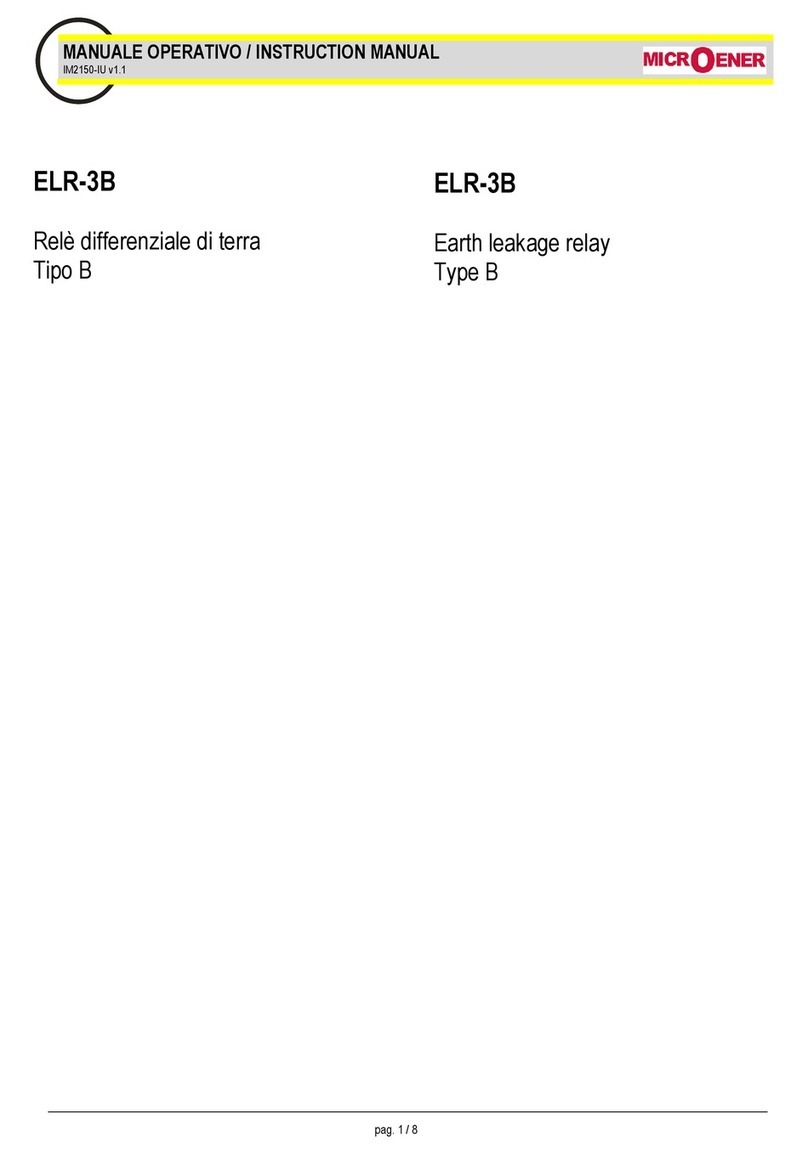
MICROENER
MICROENER ELR-3B User manual
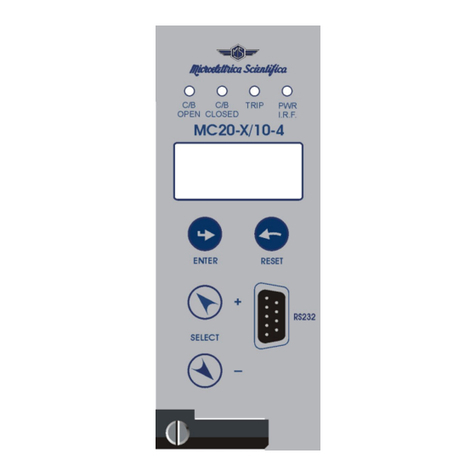
MICROENER
MICROENER MC20-X/10-4 User manual
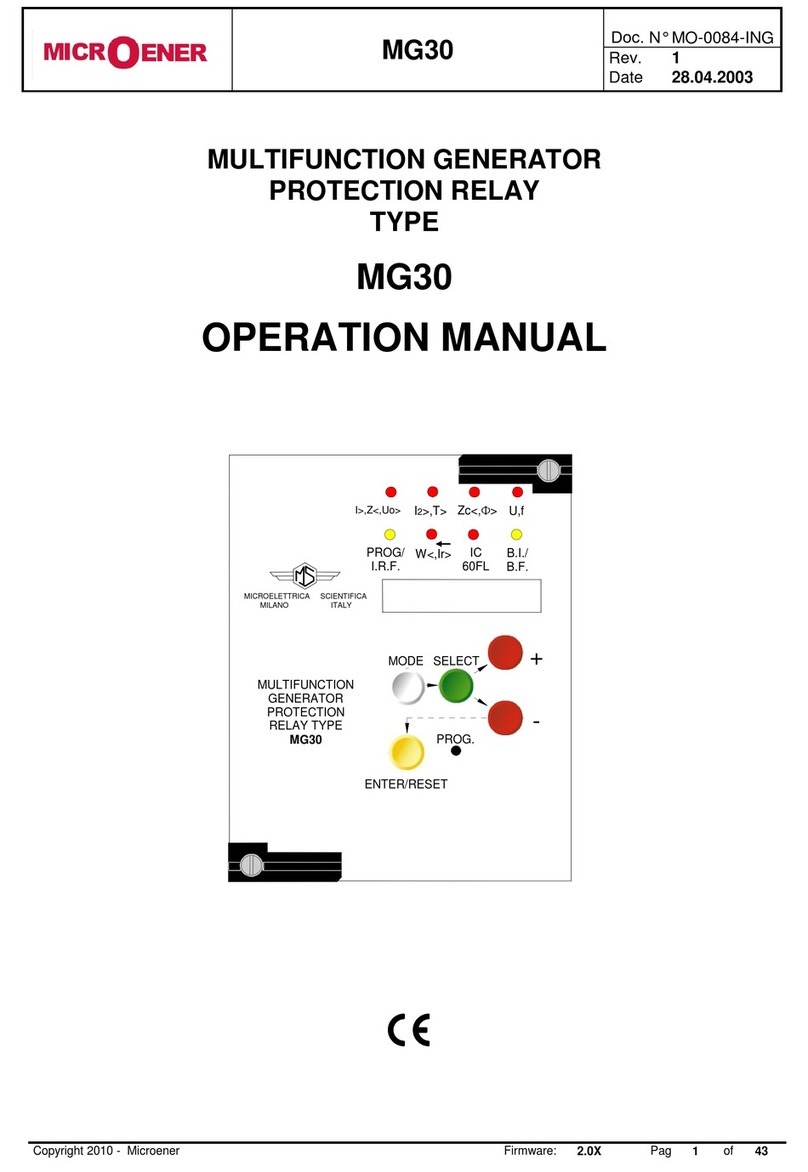
MICROENER
MICROENER MG30 User manual

MICROENER
MICROENER IM30-B00 User manual
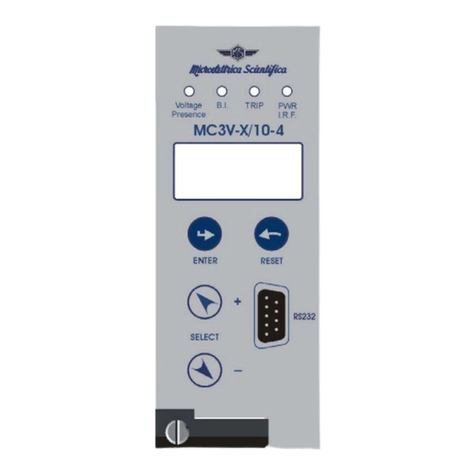
MICROENER
MICROENER MC3V-X/10-4 User manual
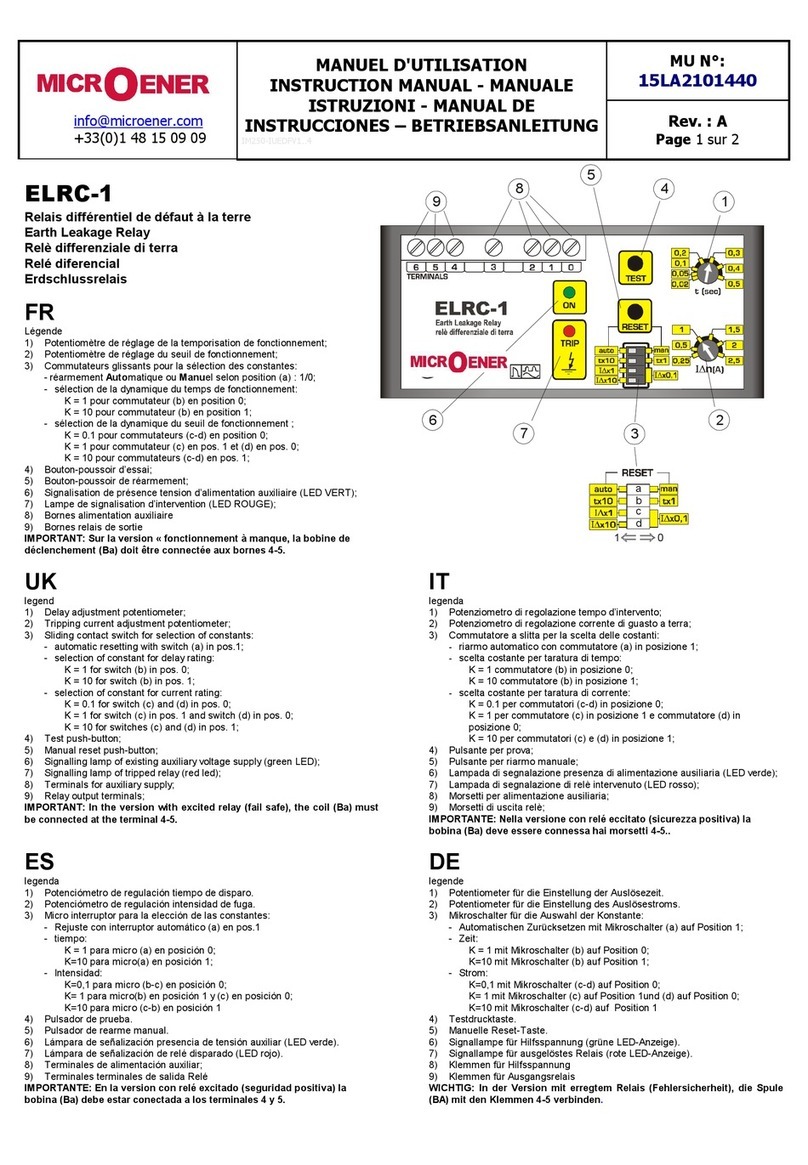
MICROENER
MICROENER ELRC-1 User manual
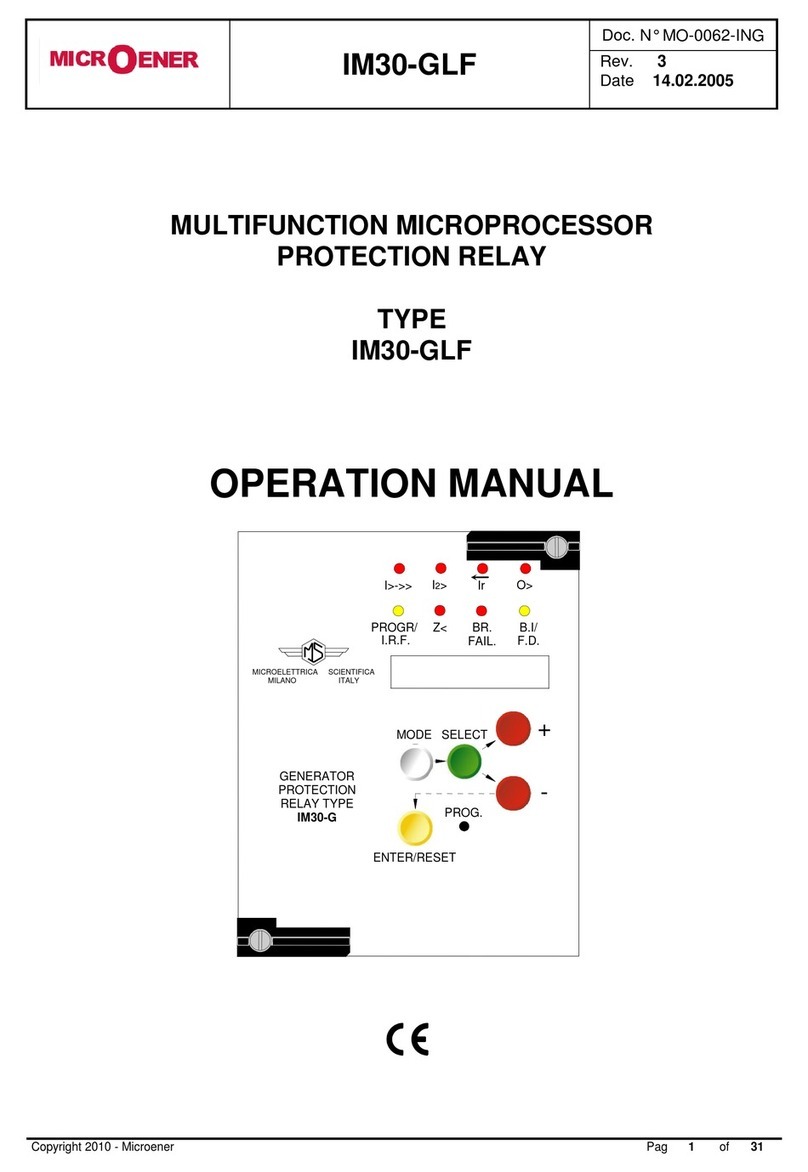
MICROENER
MICROENER IM30-GLF User manual
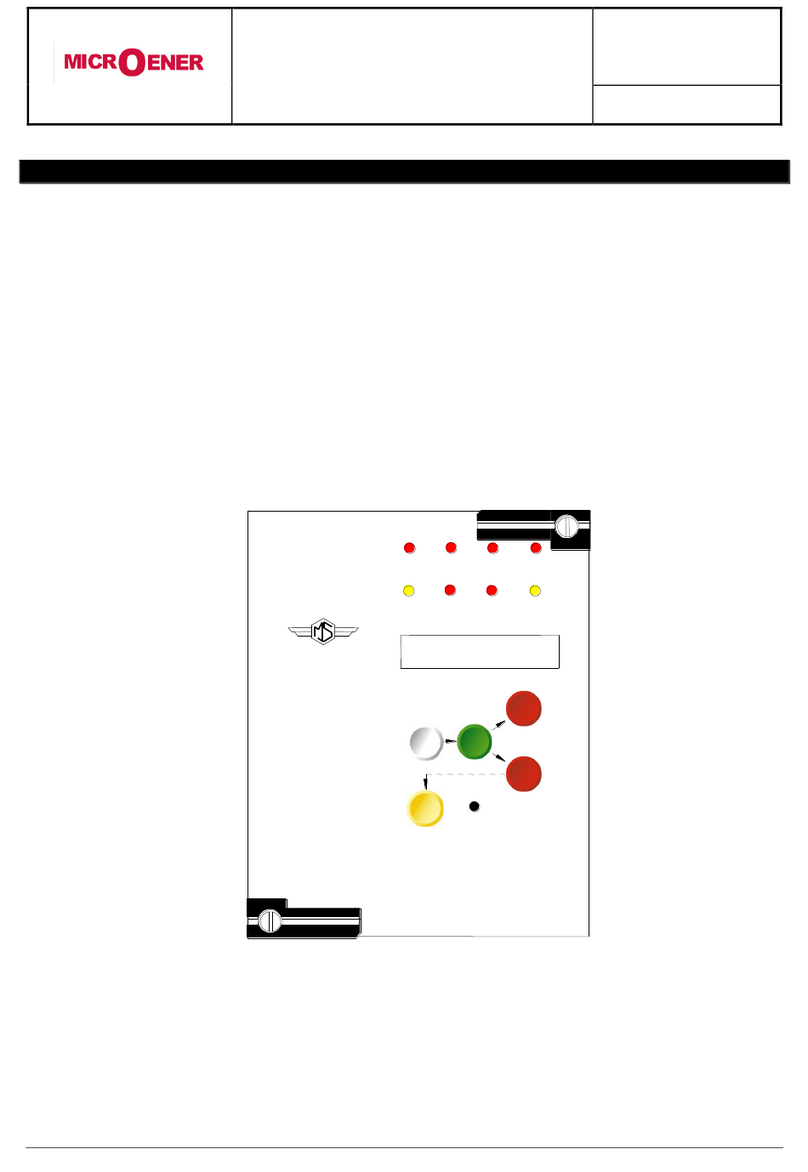
MICROENER
MICROENER M-LIB3 User manual
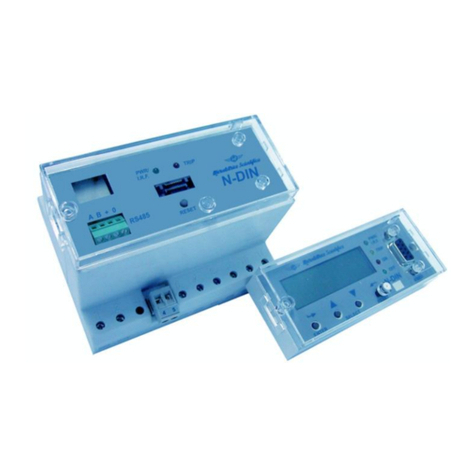
MICROENER
MICROENER N-DIN-MSG User manual
